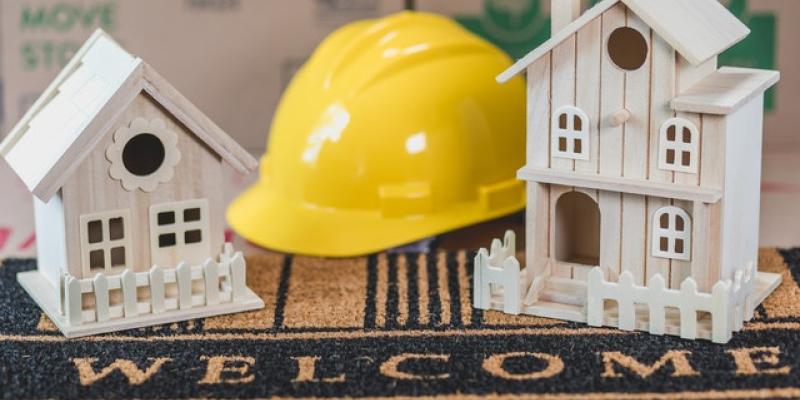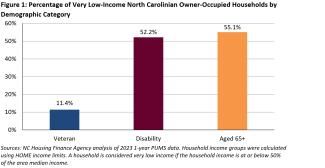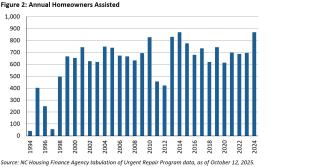
Home is more than just a place to live, it is a critical foundation for health, safety and independence. But when critical repairs are needed and resources are limited, that foundation becomes unstable. This is where the North Carolina Housing Finance Agency’s Urgent Repair Program (URP) steps in, providing assistance to the homeowners who need it most.
What is the Urgent Repair Program?
The NC Housing Finance Agency’s Urgent Repair Program addresses emergency home repair needs or accessibility modifications for very low-income homeowners with special needs (very-low incomes households are those with incomes at or below 50% of the area median income[i]). These groups include homeowners who are elderly, disabled and veteran households [ii]. These populations represent a significant subset of North Carolinians who may be in need of the critical assistance that URP provides. In North Carolina, 11.4% of very low-income owner-occupied households have a veteran household member. Additionally, households with at least one person aged 65 [iii] or above represent more than half (55.1%) of the state’s very low-income owner-occupied households and households with a person with a disability also represent more than half (52.2%) of the states very low-income owner-occupied households. See Figure 1 below.

The Agency administers URP in partnership with local governments, regional organizations and other nonprofits throughout the state, who assist homeowners with critical repairs that affect their health and safety or that cause an imminent threat of displacement. From fixing leaking roofs and replacing failing HVAC systems to installing accessibility ramps and correcting electrical hazards, URP ensures that North Carolinians can remain in their homes safely and with dignity. By focusing on these urgent home repairs and vulnerable populations, URP helps prevent displacement, institutionalization and homelessness, while also supporting aging in place and community stability.
URP Empowers Community Organizations to Help Their Neighbors
Each year, the Agency awards funding to selected partner organizations through a competitive application process. These partners receive funds to administer the program in their communities. For the 2025-2026 cycle, each organization may receive up to $165,000 (for single-county service areas) or $330,000 (for multi-county areas). These funds are used to provide deferred, forgivable loans of up to $15,000 per household to cover the cost of eligible repairs.
To learn more about how URP works and eligibility for the program, visit the Urgent Repair Program webpage.
URP Provides Significant Benefits to the Economy and Community
Affordable home repair programs like URP deliver significant health, economic and social benefits. A 2024 report from the Joint Center for Housing Studies at Harvard University found that home repairs “produce positive outcomes and that investments in home repair programs that assist low-income households yield positive social returns [on investments]”[iv]. Moreover, analyses into the costs and benefits of providing home repairs and modifications weigh heavily in favor of the benefits. A 2017 analysis of North Carolina’s URP program performed by the Agency estimated that every $1 invested in emergency home repair could save up to $19 in Medicaid/Medicare spending by helping seniors and people with disabilities to remain in their homes rather than moving into costly institutional care[v].
A 2025 systematic review of academic research further supported this, finding that home repair and modification programs provided many benefits for older adults, including enhanced safety, increased independence and the ability to age in place[vi]. Taken together, these findings reinforce the value of programs like URP—not just for individual homeowners, but also for communities and public systems as a whole.
Who Has URP Helped?
URP has played a critical role in keeping North Carolinians safe and housed for more than three decades. Since its inception in 1994, URP has committed approximately $96 million in funding to assist more than 18,500 North Carolinians. In doing so, URP has helped homeowners in all 100 counties and partnered with more than 200 organizations across the state. In 2024 alone, URP helped about 870 homeowners make critical repairs that allowed them to remain safely in their homes. Figure 2 below provides the number of homeowners that URP has assisted each year since its inception.

How to Get Involved or Apply
The Urgent Repair Program is more than just an affordable housing program—it is a source of safety, independence and stability for North Carolina’s most vulnerable homeowners. By addressing critical and imminent home repairs, URP is not only preventing displacement and institutionalization, but also strengthening neighborhoods and supporting healthier, more stable lives.
For individuals wanting to access the Urgent Repair Program, the first step is to contact a local URP partner. The Agency maintains a list of participating organizations by county on its website.
For organizations interested in becoming an URP community partner, visit the program’s webpage to learn how you can get involved.
___________________________________________________________________________
[i] In 2025, 50% area median income is equivalent to an annual household income of $57,800 for a family of four in Durham County.
[ii] In addition to elderly, disabled and veteran households, households with five or more persons, households with a single-parent with a least one dependent child and households with a child below the age of six with lead hazards in the home are also eligible populations.
[iii] For URP, eligible households with special needs include those with a household member at least 62 years old; however, the available data has an age cutoff at 65 years old.
[iv] Martin, C., Mallach, A., Swanstrom, T., Harrison, A., & Wedeen, S. (2024). “Catalyzing a Movement to Produce Greater Public, Private, and Civil Resources to Improve Housing Conditions Through Home Repair.” Joint Center for Housing Studies of Harvard University. Link.
[v] North Carolina Housing Finance Agency. (2017). “Urgent Home Repair: Quality of Life and Cost Impacts”. Link.
[vi] Cha, S. (2025). “A Systematic Review of Home Modifications for Aging in Place in Older Adults.” Healthcare. Link.